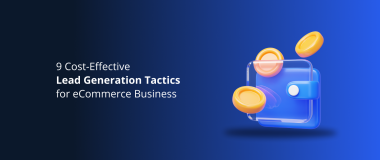Even if you’re not buried in marketing statistics, it’s quite obvious that in recent years numerous organizations and experts are doing webinars. 73% of marketers and sales representatives state that hosting webinars is great for generating high-quality leads.
Without a doubt, video has become the king of engagement. Furthermore, recent studies have found that content is driven by original research and has up to 3 times better results than rewording already written articles. These two statistics practically point to why hosting webinars is so effective when generating high-quality leads.
Webinars that are topic-based and give practical insight and an in-depth look are ideal for tailoring content to audience interests. Personalizing content in such a way lets you target topics that are interesting to your readers. They also reach potential readers or clients and offer them content they might find useful.
Although webinars are an ideal way to generate high-quality leads for your business, anyone who surfs social media knows that competition is constantly on the rise. And that is why we’ve written this guide – to help fellow marketers rise above their competitors with insightful advice and useful strategies.
Implement a Strict Schedule
Hosting webinars without any set frequency often results in poor participation levels. That’s why having a schedule – whether it be every Tuesday, the second Friday of the month, or the fifteenth of every month – is a good practice to follow.
Having a webinar schedule allows your followers not only to set aside time beforehand but creates a sense of expectation, of “I can’t wait to see what happens next”. It also diminishes that sense of uncertainty, of not knowing when the next webinar is, and if they will be free that day or have the time to watch it.
Every business requires a different schedule to fit their viewers’ needs and generate high-quality leads. Finding the one that works for you is a matter of trial and error. A good practice is to take a look at the statistics about webinar engagement rates in your industry and region, and tailor it to your audience.
Focus on the Value of Information
Many companies fill too much of their webinar with non-essential content such as a long introduction about how amazing your company is. Viewers watch webinars because they are interested in acquiring practical knowledge. They are not generally watching a video on “how to design a webpage” or “how to set up a program” because they want to know where you went to college or how many people work at your company.
To generate high-quality videos, cut out almost everything unnecessary and introduce the subject of the talk as fast as possible, limit off-topic information to 30-60 seconds. It’s also a good idea to keep in mind that the real results of your webinars will come after the users have watched the video and applied the knowledge gained on a practical level.
Furthermore, if viewers like your content, they may not only return to the next webinar; they might tell others about what they’ve learned and where. Webinars, like other marketing content nowadays, should always be geared toward fitting your audience needs.
Determine the Right Frequency
Similar to determining when to post, figuring out how often to publish depends on your audience. In the beginning, you should try establishing a routine you can easily follow. Monitor your posts and measure your performance by using both the analytics you have at your disposal thanks to social media and tools such as Hootsuite or Keyhole. This will give you insight into consumers’ psychographics and behavioral patterns.
If engagement levels start dropping, and your webinars are reaching a smaller audience than before – it’s time to introduce a less frequent schedule. If the number of viewers is constantly rising and people are actively posting comments and engaging with the brand, that’s an indicator you’re on the right track and that you can allocate more resources to making your webinars more frequent.
Base your frequency on how well users are responding and allocate resources properly to generate more high-quality leads.
Don’t Be the Only Star in Your Webinars
Partnering with other brands, influencers, and knowledge authorities could help you significantly increase your reach. Inviting a person to host a webinar with you means that you’ll be able to reach both your and their audience at the same time.
This practice will not only help increase the number of leads but if your webinar engages the invited audience, these people are most likely going to watch your next video seminar.
This is why it’s strongly advisable to partner with brands and influencers whose audience interests are the closest to your own buyer personas. This will guarantee that the content you’re producing is targeting the right audience and generating high-quality leads.
Personalize for Your Audience
To ensure that more of your viewers will be engaged, try sending out a survey to webinar registrants. Ask them which of the topics you offer are of interest to them, what they might like to see, and what might be improved on. Depending on their answers, you might need to make changes to your webinars. Remember that you can use user feedback to your advantage.
Tailoring your content according to the survey, might not engage all of your new leads but it will serve as a differentiator between viewers that fit your buyer personas, and people who are simply interested in what you’re offering.
Make Sure Users’ Feedback Is Heard

Forms to Collect Feedback, Image via ReadyTalk.com
Including a Q&A session at the end of each webinar has almost become the norm. Use this to understand your viewers and get them to share more information about their psychographics.
Real-time, direct feedback helps provide information on potential clients and their behavioral patterns, top challenges, and goals. The Q&A session with your audience is also useful for gathering ideas on what you can improve on or do in the future to generate high-quality leads.
Furthermore, any type of direct communication with the audience makes them feel their opinion is being taken into account and that they’re part of a larger community. Such marketing efforts also result in strengthened consumer loyalty towards the brand.
Advertise Your Webinars
As marketers, we all know that if you do not advertise something, all the effort you’ve invested in it is just a waste of time and resources.
For webinars, the promotion(s) need to start at least 4 or 5 weeks prior so you can reach out to a larger audience. If at first, people are not signing up in droves, don’t worry, signups often occur 7-15 days before the event. Keep in mind that almost half of the registrants are possibly attending other webinars too.
When launching a webinar campaign, use all the resources at your disposal. Promotion times are short; the effort to register is minimal, so you need to get out there and let people know about your webinar.
Post on social media at least once per week. The initial post should be engaging enough to start building interest in the webinar. It’s also important to talk about the topics that will be covered, though you shouldn’t disclose too much information about your webinar either. You want to keep your audience engaged and curious enough about the webinar to show up and learn more.
Another helpful practice is to look at your contact database and send emails to everyone that might be interested in the event. Do this a few weeks before the webinar to ensure people can include it in their plans.
Also, make sure to include social media links so people can follow the news and read more regarding the event. A topic-related blog post as a teaser for the upcoming webinar will help you introduce the subject to more users and potentially engage new prospects that weren’t so well-acquainted with it.
Furthermore, reading comments, looking at heat maps from tools like Hotjar and Crazy Egg, and seeing how the posts perform on social media could give you powerful insight into what to cover and what to improve in your next webinar to help generate more high-quality leads.
Do not forget that interstitials are quite helpful to focus user attention and thus can be perfect for promoting your webinar. It’s best to make webinar-related pop-ups appear based on user behavior. For instance, a user has visited a blog post regarding a subject related to the webinar on your website. This way can reach out to people that are actually interested in the webinar you are offering.
Engage More Leads
One of the most useful practices is to organize a simple game with prizes for those that register for the webinar. This way you can easily encourage users to share your content as part of the game’s rules.
Giving away prizes will not only encourage more people to join and share, but will make customers feel more appreciated. This strategy will help you generate high-quality leads and convert them later on.
Generate High-Quality Leads Through Webinars
With video being the king of engagement, hosting webinars has become one of the most useful practices to generate leads. When we add the ability to tailor a business topic to customers needs, targeting prospects that fit your buyer personas becomes second nature.
And despite the ever-growing competition, you can generate high-quality leads by partnering with brands, keeping a strict viewing schedule, analyzing user needs, and tailoring them to your efforts.




